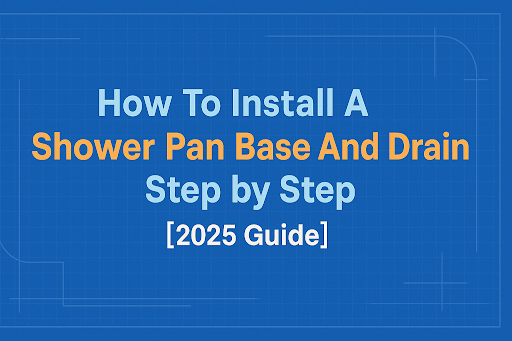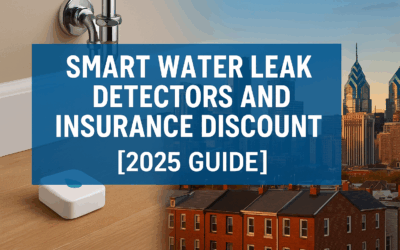In this article, we are going to talk about Philadelphia sump pump installation requirements.
Sump pumps play a crucial role in protecting homes from basement flooding and water damage. Proper installation ensures your sump pump works effectively and complies with local regulations. Whether you’re installing a new system or upgrading an existing one, understanding the city’s specific requirements, including permits, sump pit specs, discharge rules, and pump capacity, will help you avoid costly mistakes and keep your property safe.
This article covers:
- What a sump pump is and how it works
- Key components of a sump pump system
- Detailed Philadelphia sump pump installation requirements
Let’s get started!
What is a Sump Pump?
A sump pump is a device that you install in your home (usually in the basement or crawlspace) that helps prevent flooding. It pumps out water that collects in a low point called a sump pit and moves it away from your home to keep the area dry.
What Does a Sump Pump Do?
- It collects water that seeps into your basement or crawl space (from rain, groundwater, or leaks).
- When water fills up the sump pit, the pump automatically turns on.
- The pump then pumps the water out through a pipe to a safe location outside your house (like a storm drain or dry well).
- This prevents water damage, mold, and structural problems.
Components of a Sump Pump System
The main components of a sump pump include:
- Sump Pit (Basin or Sump Tank)
- A hole or basin dug into the lowest part of your basement or crawlspace.
- Collects water before the pump moves it out.
- Sump Pump
- The actual pump device placed inside the sump pit.
- Can be submersible (inside the pit) or pedestal type (motor above the pit).
- Activates when water reaches a certain level.
- Float Switch or Sensor
- Detects water level in the sump pit.
- Turns the pump on and off automatically.
- Discharge Pipe
- Pipe that carries water pumped out of the sump pit.
- Usually runs outside to a drainage area or stormwater system.
- Check Valve
- Installed on the discharge pipe to prevent water from flowing back into the sump pit after pumping.
- Power Supply
- Usually an electrical outlet powers the pump.
- Some systems have battery backup in case of power failure.
- Cover/Lid
- Covers the sump pit to prevent debris from falling in and to reduce odors.
Philadelphia Sump Pump Installation Requirements
If you’re planning to install a sump pump in Philadelphia, it’s important to follow the city’s specific rules and regulations outlined in the Philadelphia Plumbing Code and enforced by the Philadelphia Water Department. Here’s a clear breakdown of what you need to know.
1. Philadelphia Plumbing Code (2018 Amended Code)
1. Permit Requirement
A plumbing permit is mandatory for installing, enlarging, altering, repairing, or replacing any plumbing system, including sump pumps. This applies to both residential and commercial properties. The permit application must include a complete scope of work and current owner information. A licensed master plumber must oversee the work, and plans may be required depending on the complexity of the installation.
For more information about the permit process, refer to the Philadelphia Department of Licences and Inspections (L&I).
2. Sump Pit Specifications
The sump pit has specific size and construction standards under Philadelphia sump pump installation requirements:
- The pit should be at least 18 inches wide and 24 inches deep, unless otherwise approved.
- It must be made from sturdy, approved materials like concrete, tile, steel, plastic, or cast iron.
- The bottom of the pit needs to be solid and strong enough to hold the pump securely.
- The pit must be located where all water can drain into it naturally, by gravity.
- It should have a removable, gas-tight cover installed no more than 2 inches below the floor or ground surface. This cover must be strong enough to support any expected weight.
- You must vent the sump pit properly, following the guidelines in Chapter 9.
- One exception is elevator sump pits, which don’t require a sealed cover.
3. Discharge Piping
The piping that carries water away from the sump pump has to meet specific standards:
- Use materials such as copper, CPVC, ductile iron, PE, PVC, galvanized steel, or stainless steel for residential applications.
- Ensure the pipes and fittings can handle the highest pressure and temperature they might encounter.
- If the pipes are buried, they must be suitable for underground use.
- You must install a full open valve and a full flow check valve on the discharge side of the pump to prevent water from flowing back into the sump.
- You must place the valves above the sump cover. If the discharge pipe runs below ground, the valves should be in an accessible pit with a removable cover.
- The discharge pipe size should match or be larger than the pump’s discharge outlet.
4. Discharge Location
One critical aspect of Philadelphia sump pump installation requirements is where the water is discharged:
- Never direct sump pump water into the sanitary sewer system. This is strictly prohibited to avoid overloading the city’s sewage treatment plants.
- Instead, water should be directed to:
- A dry well or seepage pit,
- The stormwater sewer system,
- Or onto the ground, as long as it doesn’t cause flooding or issues for neighbors.
- A dry well or seepage pit,
5. Pump Capacity and Type
Choosing the right pump is essential for your system to work effectively:
- The pump’s capacity and power should match the expected volume of water it will handle.
- For larger or commercial systems, duplex sewage pumps or ejectors are required.
- One- and two-family homes can use simplex pumps or ejectors.
- Pumps handling sewage from toilets must be capable of handling solids up to 2 inches in diameter.
- Pumps handling other wastewater must handle solids up to ½ inch.
- The pump’s capacity must meet minimum standards based on discharge pipe size, such as:
- 21 gallons per minute (gpm) for 2-inch pipes,
- 30 gpm for 2.5-inch pipes,
- 46 gpm for 3-inch pipes.
- Grinder pumps and macerating assemblies have minimum discharge opening sizes they must meet.
6. Installation Oversight
A licensed master plumber must oversee the installation. If someone other than the master plumber applies for the permit, a signed statement on the master plumber’s letterhead confirming their association with the project is required.
Additional Considerations
- The pump’s discharge must connect properly to the building’s drainage system; this could be a building sewer, drain, soil stack, waste stack, or horizontal branch drain.
- Use a wye fitting to connect into horizontal pipes on the top side of the pipe, positioned at least ten pipe diameters away from the base of any soil or waste stacks or fixture drains.
- Electrical outlets powering the sump pump need to comply with the National Electrical Code (NFPA 70).
2. Philadelphia Water Department Regulations
In Philadelphia, the Philadelphia Water Department (PWD) enforces specific regulations concerning sump pump installations to protect the city’s water infrastructure and ensure compliance with environmental standards. Here’s a concise overview of the key requirements:
Discharge Restrictions
The city strictly prohibits discharging sump pump water into combined or sanitary sewer systems. This practice can contribute to combined sewer overflows (CSOs), which are harmful to the environment and public health.
Permitting and Compliance
- Sewer Connection Permit: A Sewer Connection Permit is required for new connections and repairs to a customer’s existing lateral to the public sewer. Connections to a private sewer, not owned or maintained by the Philadelphia Water Department, have a separate permitting process under the jurisdiction of L&I.
- Master Plumber Requirement: A licensed Master Plumber must be on-site at all times following commencement of any work governed by Section 504.0 of the Philadelphia Water Department Regulations. The Plumber must have their license or registration, personal identification, and all permits available at the work site.
PWD Permit Desk: For inquiries or to apply for permits, contact the PWD Permit Desk at the Municipal Services Building (MSB), 1401 JFK Boulevard.
Phone: 215-685-6300
Email: [email protected]
Conclusion
Understanding and following Philadelphia sump pump installation requirements is essential for keeping your property safe from flooding while ensuring compliance with city regulations. Proper permits, correctly sized and constructed sump pits, approved discharge piping, and correct pump capacity all play vital roles in an effective sump pump system. By adhering to these rules, you help protect not only your home but also the city’s infrastructure and environment. Always work with a licensed master plumber and consult local codes to make sure your installation is done right.
Planning a renovation that involves sump pump installation? Partner with Matrix for expert renovation management and coordination, ensuring your project meets all Philadelphia requirements smoothly and efficiently. Contact us today for a FREE Consultation!
FAQs
Do I need a permit to install a sump pump in Philadelphia?
Yes. A plumbing permit is required for sump pump installation, and the work must be overseen by a licensed master plumber.
What size should the sump pit be?
According to Philadelphia sump pump installation requirements, the sump pit should be at least 18 inches in diameter and 24 inches deep unless otherwise approved.
Can I discharge sump pump water into the sanitary sewer?
No. It is strictly prohibited to discharge sump pump water into the sanitary sewer to avoid overloading the sewage system. Water must be discharged to an approved stormwater system, dry well, or suitable drainage area.
What type of discharge piping is allowed?
Discharge piping must be made of approved materials such as copper, CPVC, ductile iron, PE, PVC, galvanized steel, or stainless steel, and include valves to prevent backflow.
How do I choose the right pump capacity?
The pump should match the volume of water it needs to handle and comply with code minimums based on pipe size. For residential use, simplex pumps are common; duplex pumps are used for larger applications.
Are macerating toilet systems allowed with sump pumps?
Yes, macerating toilet systems are allowed but must comply with specific standards (ASME A112.3.4/CSA B45.9) and be installed according to manufacturer instructions. They are generally limited to one- and two-family homes.
Who enforces the sump pump installation requirements?
The Philadelphia Plumbing Code governs the technical installation requirements, while the Philadelphia Water Department enforces discharge restrictions and permitting compliance.









![Top 20 Reasons for Failing a Plumbing Inspection in Philadelphia [2025 Guide]](https://matrixgc.com/wp-content/uploads/2025/05/Common-issues-causing-failing-a-plumbing-inspection-in-Philadelphia.png)
0 Comments